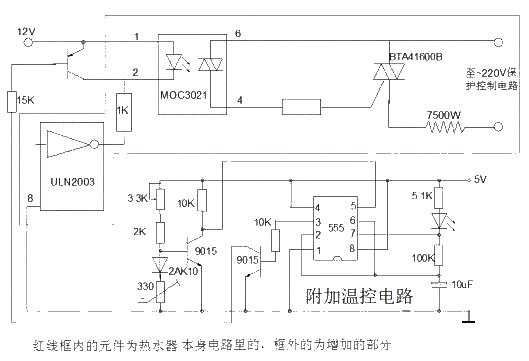Instantaneous water heater automatic constant temperature experimental circuit diagram
Source: InternetPublisher:张小哥 Keywords: Water heater circuit diagram experimental circuit switch Updated: 2021/06/01
I have been using the instantaneous water heater at home for many years, but every time I take a bath, I feel troubled. The water temperature control of the water heater is divided into 9 levels. The larger the number from 1 to 9, the higher the temperature. It should be easy to use. However, the water flow can also control the water temperature, and often causes the temperature to be out of control. For example, the water pressure decreases and the water volume becomes smaller. The heat cannot be taken away by the water immediately. The temperature (protection) switch inside the water heater will activate and you will be scalded. It is very uncomfortable to be tortured by cold water after a while.
In order to change this situation, I added a simple temperature control circuit, which can control the heating time of the original circuit, that is, the duty cycle. The effect is satisfactory, especially the temperature (protection) switch inside the water heater never operates again, which is very comfortable. .
The temperature sensor in the circuit uses an old-fashioned thermistor. Since the resistance is a bit small, a germanium diode is added for this purpose.
The main components used in the water heater circuit are: ULN2003AN, 7805/7812, BTA41600B, JQX-15F, HMS87C1202A, MOC3021.

- How much current can a 2N3055 solar cell produce? How can I get 3055V from a 12N2 solar cell?
- Cleverly use the electronic ballast of waste energy-saving lamps as power supply transformer
- Fabrication of multi-cell lithium battery charging circuit
- Brief Analysis of the Working Principle of AC Voltage Stabilizer Circuit
- Boost drive circuit composed of RT8450
- Adjustable regulated power supply with current limiting protection
- Self-made high-stability, high-current, DC adjustable voltage-stabilized power supply using operational amplifier
- Homemade Electric Bike Fast Charger
- Detailed explanation of mobile phone charger circuit diagram
- Solar Lead Acid Battery Charger
- The service life of some components of the switching power supply
- Furnace door interlock switch control circuit
- Light controlled safety circuit switch circuit diagram
- Emergency braking circuit when accelerator is pressed accidentally
- Paper tension control circuit
- TN-S power supply mode circuit
- Typical relaxation oscillator and its output voltage waveform
- Single pulse signal generating circuit b
- Keying pulse signal generation circuit
- Lithium battery charger circuit







 京公网安备 11010802033920号
京公网安备 11010802033920号